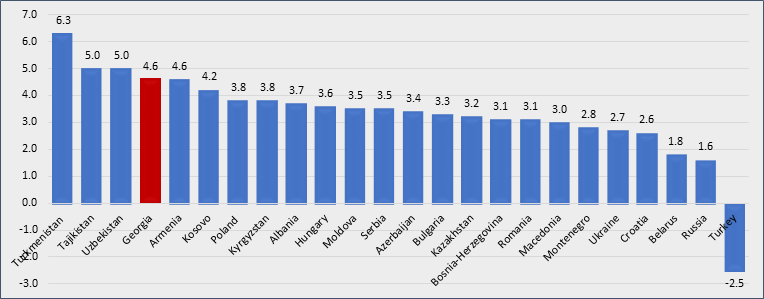Resume: The International Monetary Fund updated its economic growth estimates most recently in April 2019. As a result, economic growth estimates for the whole world and for certain country groups decreased.
At the present moment, Georgia’s estimated economic growth rate is 4.6% (the World Bank has the same estimate). The estimated economic growth rate for neighbouring Armenia is 4.6% for the same year. With these figures, Armenia and Georgia share the fourth and fifth positions in the region (Europe and Central Asia – Developing Countries) whilst Turkmenistan (6.3%), Tajikistan (5.0%) and Uzbekistan (5.0%) are in the top three.
In the last four years, Georgia ranked 11th in terms of the annual average economic growth whilst it is 3rd in the region for the next years according to current estimates.
Therefore, Georgia is ranked higher in the region in 2019 as compared to the previous years in terms of the estimated economic growth rate with current estimates not making it a regional leader. In addition, Georgia will be ranked 3rd in 2020-2022 as well.
Analysis
The Minister of Finance of Georgia, Ivane Machavariani, during the committee hearing at the Parliament of Georgia, spoke about the International Monetary Fund’s updated economic growth estimates. As stated by the Minister, even though the world’s economic growth estimate decreased, Georgia is the leader in the region in terms of estimated economic growth.
Before we move to the analysis itself, it is important to clearly define the region where Georgia belongs in that this is relevant for comparison. In a narrow definition of a region, we can assume Georgia’s neighbourhood (Armenia, Azerbaijan, Turkey and Russia). The International Monetary Fund thinks of Georgia as a CIS member country (even though Georgia is no longer a CIS-member country). However, in accordance with the World Bank’s country groups, Georgia is in the Europe and Central Asia country region (excluding the high-income nations). In turn, CIS member countries also are part of that group with the economies of this region’s countries having more or less similar characteristics. In addition, the countries of this group have close trade relations with each other. Therefore, Georgia’s economic growth vis-à-vis the region should be considered against Europe and Central Asia’s 24 non-high income countries. It is also possible to make comparisons with CIS member countries given that this is something the International Monetary Fund does.
The International Monetary Fund updated the World Economic Outlook (WEO) and, respectively, the economic growth estimates in April 2019. As a result of the aforementioned update, the world’s estimated economic growth rate for 2019 dropped by 0.2 of a percentage point as compared to the estimated growth rate in January 2019. In accordance with the International Monetary Fund’s estimates, the world’s economic growth rate for 2019 and 2020 is 3.3% and 3.6%, respectively. In regard to countries with developing economies, the International Monetary Fund slashed the estimated economic growth rate from 4.5% to 4.4% and placed it at 4.8% for 2020. On the contrary, the International Monetary Fund increased the estimated economic growth rate by 0.1 of a percentage point to 0.8% for Europe’s developed economies as compared to what it was in January 2019. However, of note is that this figure is 1.2 percentage points lower as compared the estimates for October 2018. The International Monetary Fund also decreased the estimated economic growth rates for the Eurozone and the EU. As per current estimates, the economic growth for the Eurozone is expected to be 1.3% (1.5% for 2020) and 1.6% (1.7% for 2020) for the EU.
Graph 1: Economic Growth in terms of Country Groups (%)

Source: International Monetary Fund
After the April updates, the International Monetary Fund left the CIS (the IMF puts Georgia into this group) estimated economic growth rate unchanged. The estimated economic growth rate for the CIS in 2019 is 2.2% whilst it is 2.3% in 2020. Of note is that the economic growth of the CIS countries, which are Georgia’s main trade partners, have a substantial impact upon Georgia’s economic situation. In Georgia’s total exports for the first quarter of 2019, the share of the CIS is 50.4% whilst its share in the country’s total imports is 29.1%.
Of Europe and Central Asia (without high-income) region countries as well as of the CIS countries, Turkmenistan has the highest estimated economic growth rate with 6.3%. Turkmenistan is followed by Tajikistan and Uzbekistan, each with a 5% estimated economic growth rate. Georgia, together with Armenia, shares the fourth and fifth positions with a 4.6% estimated economic growth rate. Therefore, in accordance with the 2019 economic growth estimates, Georgia is not the leader country in the region. In addition, of Georgia’s immediate neighbours, Armenia’s estimated economic growth rate is also 4.6%.
In regard to the estimated average annual economic growth rate for 2019-2022, Georgia is ranked 3rd in the region whilst Turkmenistan and Uzbekistan share the first two positions and Tajikistan is ranked 4th. In regard to the past period, Georgia was ranked 11th of the region’s 24 countries with a 3.8% average annual economic growth rate in 2015-2018. In the past four years, Uzbekistan has had the highest average annual economic growth rate of the region’s countries with 7.7%. In addition, the following countries also had high economic growth rates: Tajikistan, Turkmenistan, Romania, Turkey and Poland.
Graph 2: Estimated Economic Growth Rates for 2019 (%)[1]









